人教版(2019)必修第二册Unit 1 History and traditions Assessing Your Progress 课件(32张ppt)
文档属性
| 名称 | 人教版(2019)必修第二册Unit 1 History and traditions Assessing Your Progress 课件(32张ppt) | 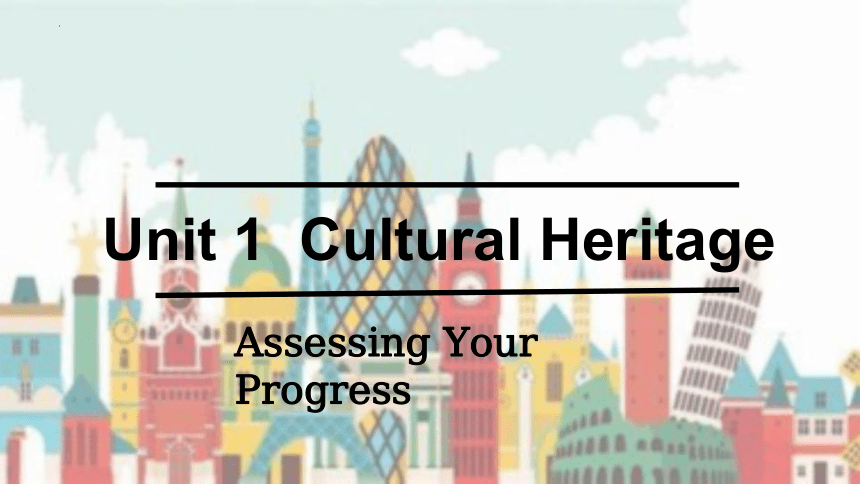 | |
| 格式 | zip | ||
| 文件大小 | 3.3MB | ||
| 资源类型 | 教案 | ||
| 版本资源 | 人教版(2019) | ||
| 科目 | 英语 | ||
| 更新时间 | 2022-09-11 18:06:49 | ||
图片预览

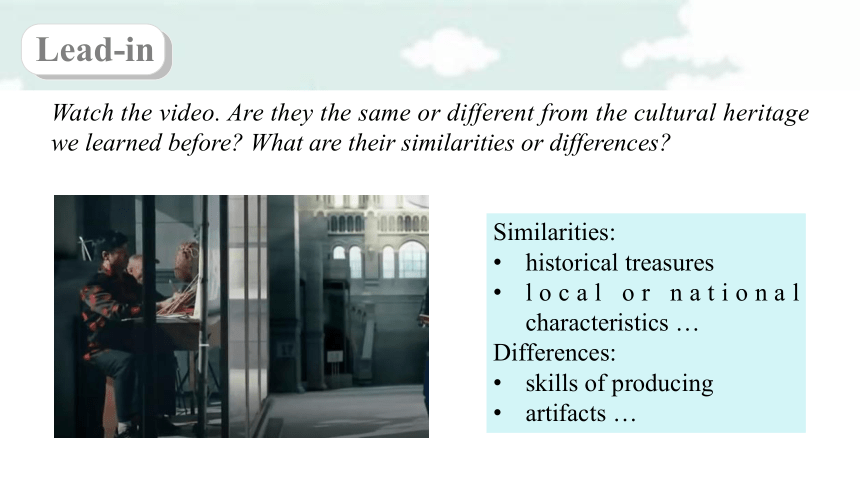
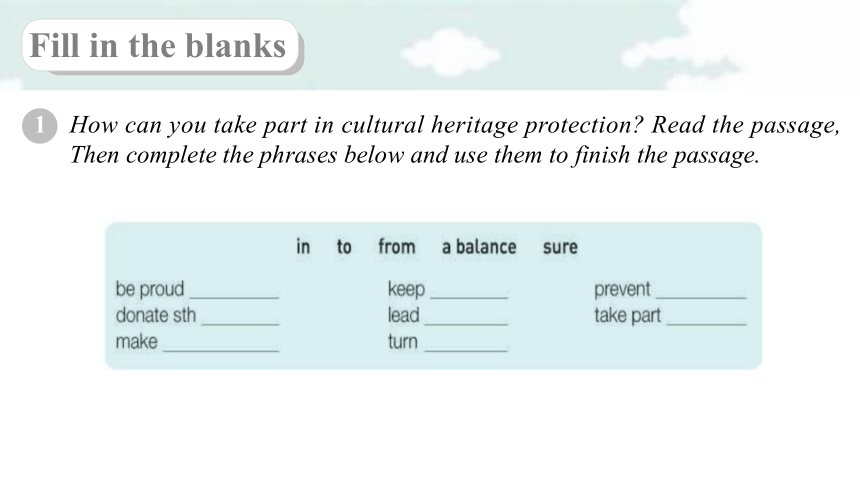
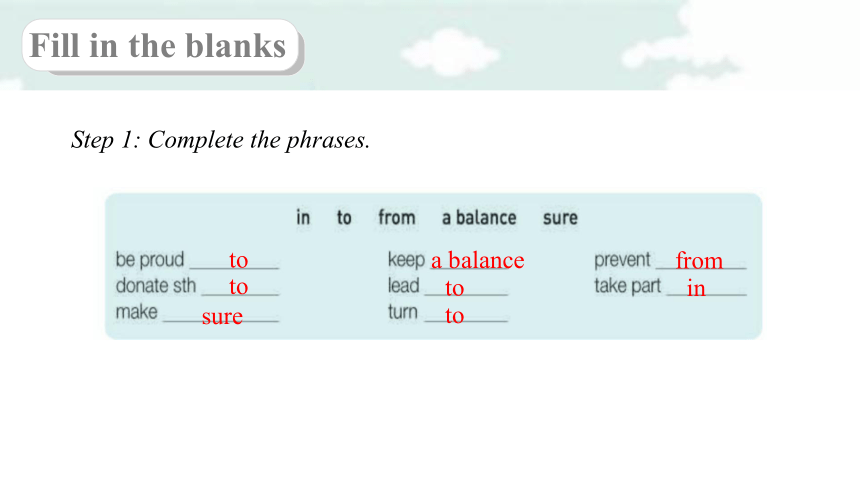
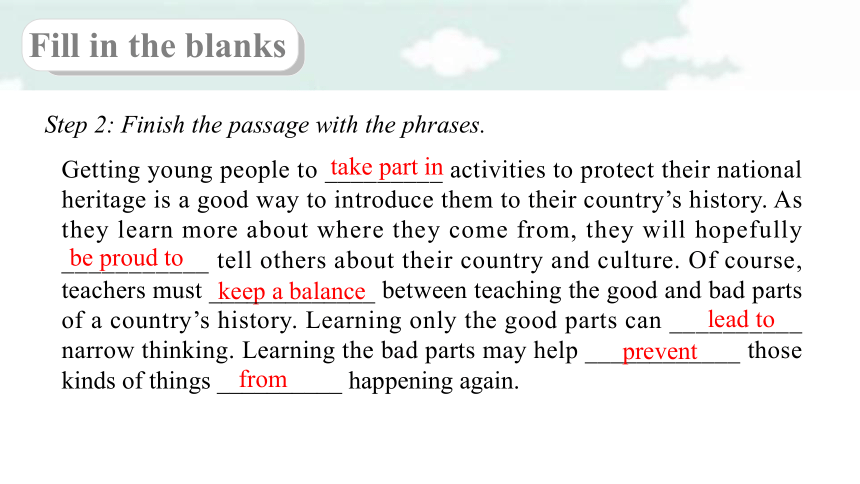
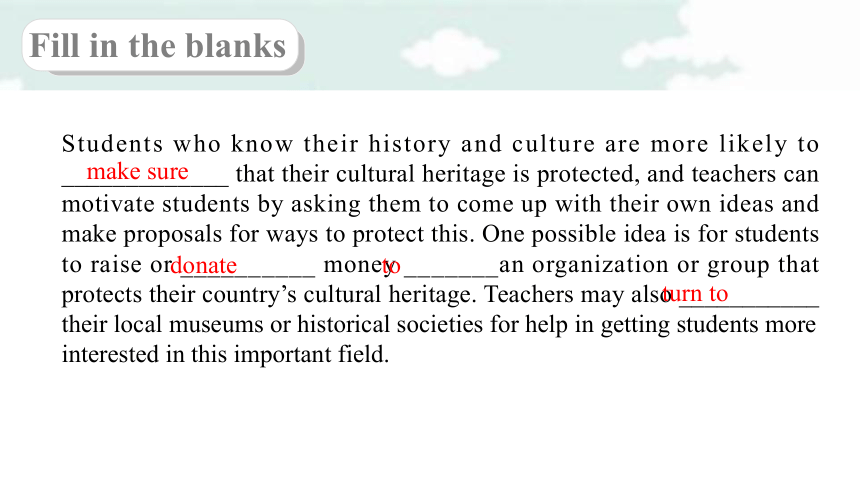
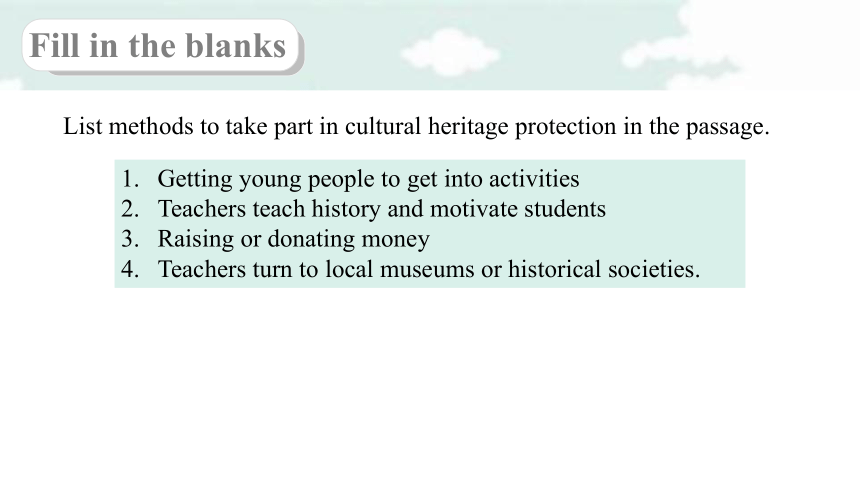
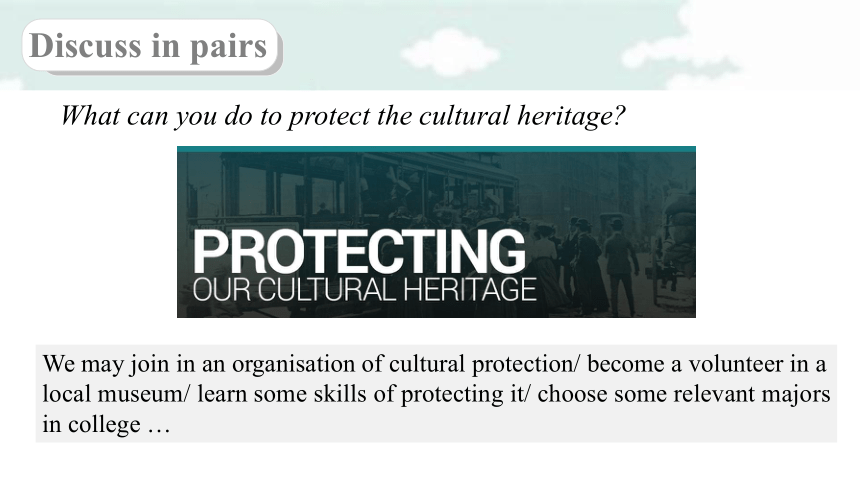
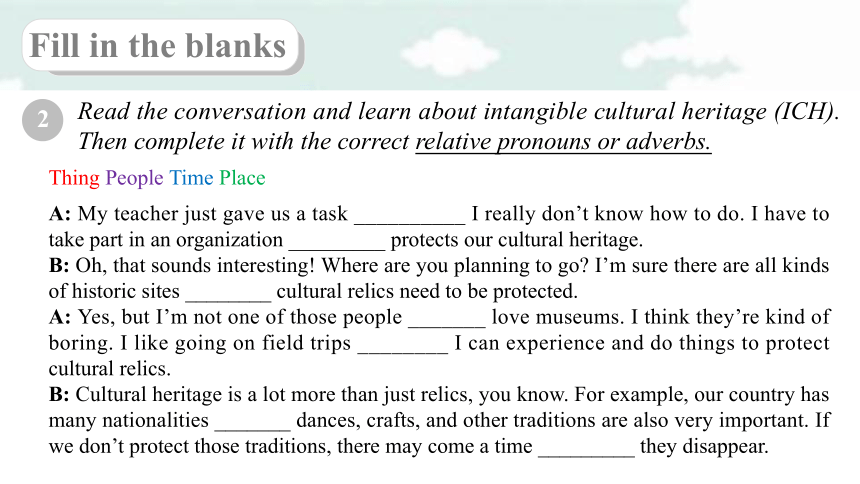
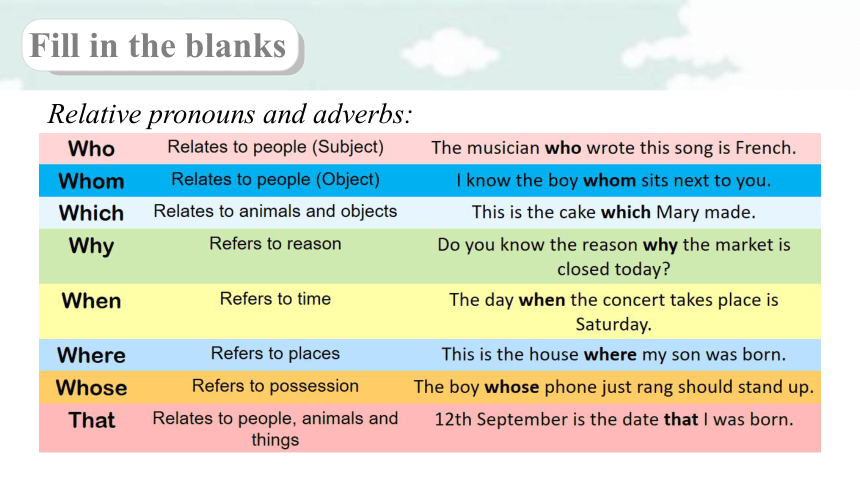
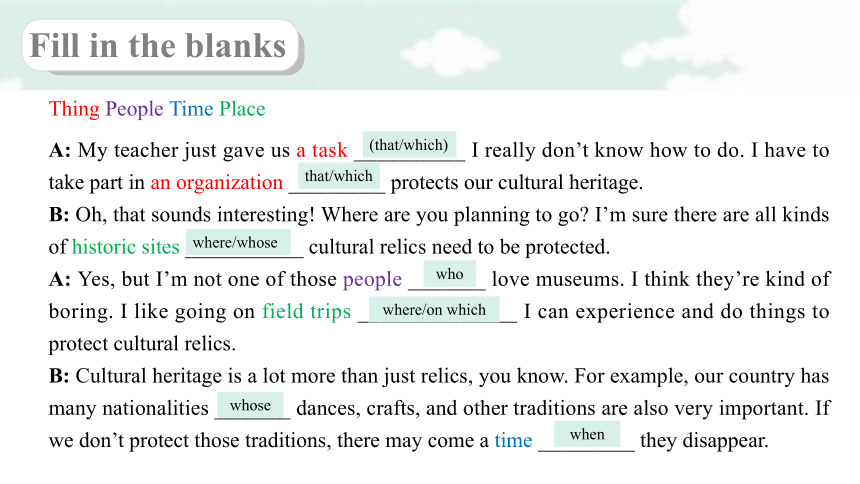
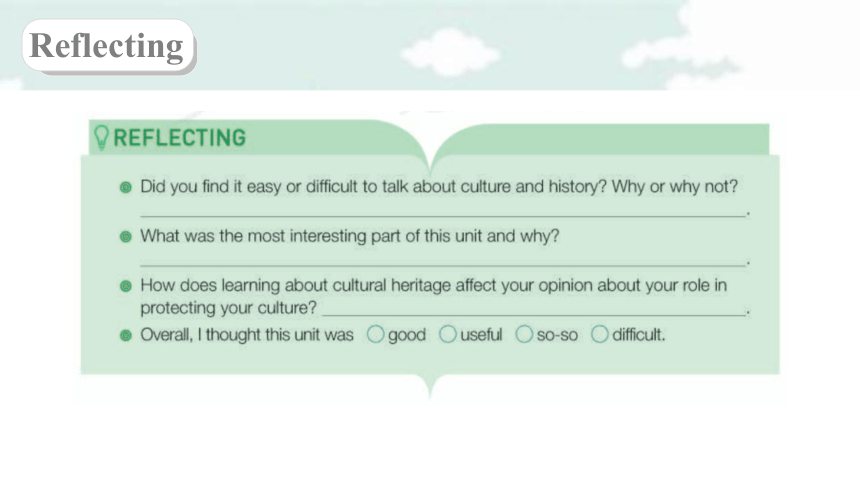
文档简介
(共32张PPT)
Unit 1 Cultural Heritage
Assessing Your Progress
Watch the video. Are they the same or different from the cultural heritage we learned before What are their similarities or differences
Lead-in
Similarities:
historical treasures
local or national characteristics …
Differences:
skills of producing
artifacts …
Fill in the blanks
1
How can you take part in cultural heritage protection Read the passage, Then complete the phrases below and use them to finish the passage.
Step 1: Complete the phrases.
to
to
sure
a balance
to
to
from
in
Fill in the blanks
take part in
be proud to
keep a balance
Getting young people to _________ activities to protect their national heritage is a good way to introduce them to their country’s history. As they learn more about where they come from, they will hopefully ___________ tell others about their country and culture. Of course, teachers must _____________ between teaching the good and bad parts of a country’s history. Learning only the good parts can __________ narrow thinking. Learning the bad parts may help ____________ those kinds of things __________ happening again.
lead to
prevent
from
Step 2: Finish the passage with the phrases.
Fill in the blanks
make sure
Students who know their history and culture are more likely to _____________ that their cultural heritage is protected, and teachers can motivate students by asking them to come up with their own ideas and make proposals for ways to protect this. One possible idea is for students to raise or __________ money _______an organization or group that protects their country’s cultural heritage. Teachers may also ___________ their local museums or historical societies for help in getting students more interested in this important field.
donate
to
turn to
Fill in the blanks
List methods to take part in cultural heritage protection in the passage.
Fill in the blanks
Getting young people to get into activities
Teachers teach history and motivate students
Raising or donating money
Teachers turn to local museums or historical societies.
What can you do to protect the cultural heritage
We may join in an organisation of cultural protection/ become a volunteer in a local museum/ learn some skills of protecting it/ choose some relevant majors in college …
Discuss in pairs
Read the conversation and learn about intangible cultural heritage (ICH). Then complete it with the correct relative pronouns or adverbs.
2
A: My teacher just gave us a task __________ I really don’t know how to do. I have to take part in an organization _________ protects our cultural heritage.
B: Oh, that sounds interesting! Where are you planning to go I’m sure there are all kinds of historic sites ________ cultural relics need to be protected.
A: Yes, but I’m not one of those people _______ love museums. I think they’re kind of boring. I like going on field trips ________ I can experience and do things to protect cultural relics.
B: Cultural heritage is a lot more than just relics, you know. For example, our country has many nationalities _______ dances, crafts, and other traditions are also very important. If we don’t protect those traditions, there may come a time _________ they disappear.
Fill in the blanks
Thing People Time Place
Relative pronouns and adverbs:
Fill in the blanks
A: My teacher just gave us a task __________ I really don’t know how to do. I have to take part in an organization _________ protects our cultural heritage.
B: Oh, that sounds interesting! Where are you planning to go I’m sure there are all kinds of historic sites ___________ cultural relics need to be protected.
A: Yes, but I’m not one of those people _______ love museums. I think they’re kind of boring. I like going on field trips ______________ I can experience and do things to protect cultural relics.
B: Cultural heritage is a lot more than just relics, you know. For example, our country has many nationalities _______ dances, crafts, and other traditions are also very important. If we don’t protect those traditions, there may come a time _________ they disappear.
Fill in the blanks
Thing People Time Place
(that/which)
that/which
where/whose
who
where/on which
whose
when
Reflecting
What is it
Beijing Opera
Background information
What is it
Traditional Chinese Kites
Background information
What is it
Chinese Paper-cut
Background information
What is it
Chinese Calligraphy
Background information
Learn about intangible cultural heritage (ICH)
A country’s cultural heritage includes not only temples, palaces, and other cultural relics, but also its traditions, customs, and knowledge, such as dances, arts, and crafts. Learn more about intangible cultural heritage and prepare a class presentation.
Project
Work in pairs. Look at the examples of Chinese ICH and discuss the questions.
4
Are you familiar with any of these examples of Chinese ICH Tell your partner what you know about them.
Project
Think about:
history, place of origin, features
…
Work in pairs. Look at the examples of Chinese ICH and discuss the questions.
4
Have you ever observed or taken part in any of them If so, when and where Share your experiences with your partner.
Project
Think about:
your experiences, feelings, reflection
…
Work in pairs. Look at the examples of Chinese ICH and discuss the questions.
4
What other kinds of ICH do you know about Share what you know with your partner.
Project
Discuss in groups. What are the key points for you to grasp when you are about to represent others the ICH
Project
1. Think about what you need to know about intangible cultural heritage
Project
2. Work in groups. Choose something that represents ICH. Use the library or the Internet to do research.
Project
3. Make a presentation to the class about the ICH that you have chosen.
What can we do to make our presentation more attractive and persuasive
Project
We could …
use some software such as PowerPoint slide to organize our presentation.
Project
We could …
be clear of the tasks of each group member such as choosing the representative or speaker for the group
Project
We could …
demonstrate or display the crafts or skills in person.
Project
We could …
make an outline or a script for preparation
Project
We could …
practice hard before our presentation
Project
Now, let’s enjoy the presentation!
Project
After listen to the presentation of different groups in class, please write evaluation and recommendation for their presentations.
Think about
Topic
Main content
Structure
Presentation style
…
Homework
Thanks!
Unit 1 Cultural Heritage
Assessing Your Progress
Watch the video. Are they the same or different from the cultural heritage we learned before What are their similarities or differences
Lead-in
Similarities:
historical treasures
local or national characteristics …
Differences:
skills of producing
artifacts …
Fill in the blanks
1
How can you take part in cultural heritage protection Read the passage, Then complete the phrases below and use them to finish the passage.
Step 1: Complete the phrases.
to
to
sure
a balance
to
to
from
in
Fill in the blanks
take part in
be proud to
keep a balance
Getting young people to _________ activities to protect their national heritage is a good way to introduce them to their country’s history. As they learn more about where they come from, they will hopefully ___________ tell others about their country and culture. Of course, teachers must _____________ between teaching the good and bad parts of a country’s history. Learning only the good parts can __________ narrow thinking. Learning the bad parts may help ____________ those kinds of things __________ happening again.
lead to
prevent
from
Step 2: Finish the passage with the phrases.
Fill in the blanks
make sure
Students who know their history and culture are more likely to _____________ that their cultural heritage is protected, and teachers can motivate students by asking them to come up with their own ideas and make proposals for ways to protect this. One possible idea is for students to raise or __________ money _______an organization or group that protects their country’s cultural heritage. Teachers may also ___________ their local museums or historical societies for help in getting students more interested in this important field.
donate
to
turn to
Fill in the blanks
List methods to take part in cultural heritage protection in the passage.
Fill in the blanks
Getting young people to get into activities
Teachers teach history and motivate students
Raising or donating money
Teachers turn to local museums or historical societies.
What can you do to protect the cultural heritage
We may join in an organisation of cultural protection/ become a volunteer in a local museum/ learn some skills of protecting it/ choose some relevant majors in college …
Discuss in pairs
Read the conversation and learn about intangible cultural heritage (ICH). Then complete it with the correct relative pronouns or adverbs.
2
A: My teacher just gave us a task __________ I really don’t know how to do. I have to take part in an organization _________ protects our cultural heritage.
B: Oh, that sounds interesting! Where are you planning to go I’m sure there are all kinds of historic sites ________ cultural relics need to be protected.
A: Yes, but I’m not one of those people _______ love museums. I think they’re kind of boring. I like going on field trips ________ I can experience and do things to protect cultural relics.
B: Cultural heritage is a lot more than just relics, you know. For example, our country has many nationalities _______ dances, crafts, and other traditions are also very important. If we don’t protect those traditions, there may come a time _________ they disappear.
Fill in the blanks
Thing People Time Place
Relative pronouns and adverbs:
Fill in the blanks
A: My teacher just gave us a task __________ I really don’t know how to do. I have to take part in an organization _________ protects our cultural heritage.
B: Oh, that sounds interesting! Where are you planning to go I’m sure there are all kinds of historic sites ___________ cultural relics need to be protected.
A: Yes, but I’m not one of those people _______ love museums. I think they’re kind of boring. I like going on field trips ______________ I can experience and do things to protect cultural relics.
B: Cultural heritage is a lot more than just relics, you know. For example, our country has many nationalities _______ dances, crafts, and other traditions are also very important. If we don’t protect those traditions, there may come a time _________ they disappear.
Fill in the blanks
Thing People Time Place
(that/which)
that/which
where/whose
who
where/on which
whose
when
Reflecting
What is it
Beijing Opera
Background information
What is it
Traditional Chinese Kites
Background information
What is it
Chinese Paper-cut
Background information
What is it
Chinese Calligraphy
Background information
Learn about intangible cultural heritage (ICH)
A country’s cultural heritage includes not only temples, palaces, and other cultural relics, but also its traditions, customs, and knowledge, such as dances, arts, and crafts. Learn more about intangible cultural heritage and prepare a class presentation.
Project
Work in pairs. Look at the examples of Chinese ICH and discuss the questions.
4
Are you familiar with any of these examples of Chinese ICH Tell your partner what you know about them.
Project
Think about:
history, place of origin, features
…
Work in pairs. Look at the examples of Chinese ICH and discuss the questions.
4
Have you ever observed or taken part in any of them If so, when and where Share your experiences with your partner.
Project
Think about:
your experiences, feelings, reflection
…
Work in pairs. Look at the examples of Chinese ICH and discuss the questions.
4
What other kinds of ICH do you know about Share what you know with your partner.
Project
Discuss in groups. What are the key points for you to grasp when you are about to represent others the ICH
Project
1. Think about what you need to know about intangible cultural heritage
Project
2. Work in groups. Choose something that represents ICH. Use the library or the Internet to do research.
Project
3. Make a presentation to the class about the ICH that you have chosen.
What can we do to make our presentation more attractive and persuasive
Project
We could …
use some software such as PowerPoint slide to organize our presentation.
Project
We could …
be clear of the tasks of each group member such as choosing the representative or speaker for the group
Project
We could …
demonstrate or display the crafts or skills in person.
Project
We could …
make an outline or a script for preparation
Project
We could …
practice hard before our presentation
Project
Now, let’s enjoy the presentation!
Project
After listen to the presentation of different groups in class, please write evaluation and recommendation for their presentations.
Think about
Topic
Main content
Structure
Presentation style
…
Homework
Thanks!
